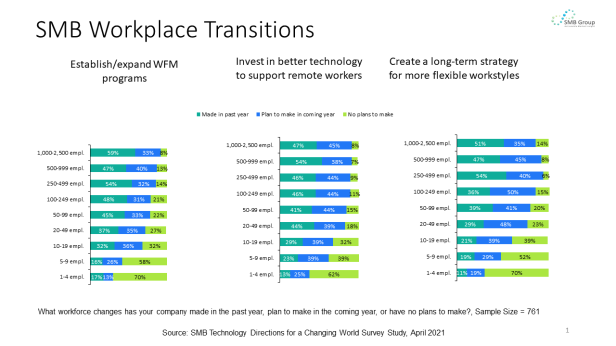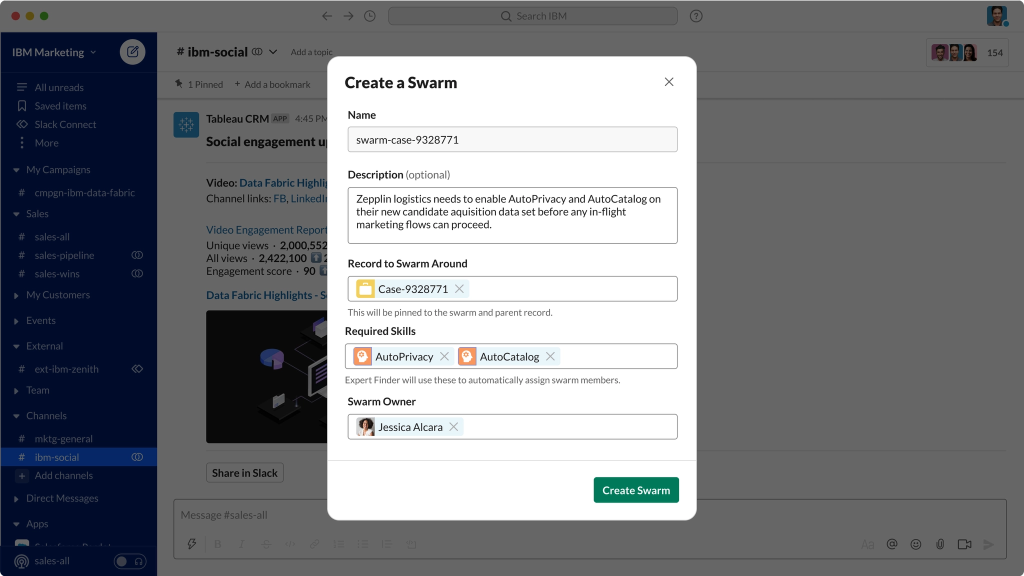Salesforces’ 2021 Dreamforce reflected how the pandemic is changing events: After conducting an all-virtual event in 2020, Salesforce conducted this year’s Dreamforce as a hybrid event. Most participants attended sessions virtually via the company’s new Salesforce+ platform, with a small number of customers and partners attending in person at the event’s mainly outdoor venues.
The event also underscored just how much Salesforce has grown from its disruptive cloud start up roots in 1999, to the software behemoth it’s become today. With 66 acquisitions under its belt since its inception—in addition to its organic growth–Dreamforce has grown to encompass hundreds of sessions and likely hundreds of takeaways as well.
However, two rise to the top for me: the new Salesforce+ platform, and Salesforce’s plans to use Slack to help customers create “digital headquarters” to connect customers, partners and employees. Both reflect CEO Marc Benioff’s belief that the pandemic has forever changed the way we’ll work—and that many people won’t be going back to business as usual.
Salesforce+
Salesforce debuted Salesforce+ at Dreamforce, literally putting the new service on center stage to stream sessions, presumably to jump start customer interest in the platform. Beyond Dreamforce, Salesforce will use the platform to stream original content, including live experiences, original series, podcasts and more, designed for business professions. training, information, inspiration and guidance for businesses professionals.
The platform provides Salesforce with a virtual, interactive way to engage with customers, prospects and partners in our now hybrid world. By providing a destination channel for all of its content, with different channels focused on different interests and requirements, Salesforce+ should help customers more easily find what they need, when they need it.
Salesforce+ is not a trivial undertaking, however, leading to speculation on what else may be in store. Almost certainly, Salesforce wants an alternative to Microsoft LinkedIn and LinkedIn Live—and perhaps someday compete against business-focused cable and streaming media channels. Salesforce could, for instance, monetize Salesforce+ by creating opportunities for partners and even customers to produce content or ads to air on the platform.
Slack
Salesforce closed its $27.7 billion acquisition of Slack, its biggest buy yet, in July. Slack helps people connect and collaborate via chat, calls and integrations with third-party solutions, from Adobe to Zoom. Popular before the pandemic, Slack’s revenues grew by $902 million revenue between March 2020 to April 2021, a whopping 43% year-over-year increase.
Slack fits right into Salesforce’s view of the future. Despite recently investing millions to build the 61-floow Salesforce Tower in San Francisco, Benioff has made it clear that many at Salesforce itself won’t be using this space, telling CNBC he expects more than half of his employees to work from home even after the pandemic.
Decision-makers in SMB and midmarket companies agree, according to SMB Group research. Companies are continuing to expand in work-from-home programs, invest in better technology to support remote workers, and to develop long-term strategies to enable more flexible workstyles.

By further integrating Slack with Salesforce solutions, the vendor aims to help customers to create “DigitalHQs”—designed to help people to work anywhere, anytime, and to provide more engaging, productive and personalized workspaces for employees, partners and customers.
Salesforce’s Slack-First Customer 360 Solution combines Slack with the Salesforce platform across sales, marketing, service, commerce, integration and analytics workflows. This connection is designed to help people collaborate more easily and get things done faster via Slacks’ conversational user interface.
Salesforce has already released a new integration between Datorama (Salesforce Marketing Cloud’s marketing intelligence platform) and Slack to provide marketing employees with notifications when marketing assets change.
Slack-First Sales, now in the pipeline, empowers sales teams to collaborate in real-time to close more deals faster, from anywhere. With digital deal rooms, sales reps now have the ability to access, update, and share Salesforce records directly in Slack, and new alert capabilities help teams stay up-to-date and aligned on important account updates. Slack-First Service allows service teams to automatically identify and bring the right experts into a case. New swarming and expert finder capabilities allow cross-functional teams to collaborate on priority incidents to resolve customer cases more efficiently and effectively.
Salesforce is introducing new Slack features as well:
- Clips lets users easily create, share and consume video and audio content in channels, enabling them to contribute to the conversation on their own time
- Huddles allows users make audio calls to colleagues in a way that’s supposed to replicate spontaneous hallway conversations.
In addition, Salesforce announced Foyer,a toolkit for to help Salesforce developers more easily create Slack apps. According to Salesforce, Foyer provides both an SDK for UI development and a service proxy that dynamically generates the endpoints needed to power Slack apps.
And what happens to Salesforce Chatter, one of the first real-time messaging apps? According to the company, Chatter will remain in the portfolio as an option for intra-company collaboration only.
Perspective
The pandemic forced an almost overnight, en masse shift to remote work, and has forever changed people’s expectations of when, where and how work gets done.
With Salesforce+ and Slack-First Customer 360, the seemingly ever-prescient Marc Benioff is setting the stage for Salesforce to lead as this still uncertain new world of work takes shape.
However, both of these very big bets are still in the very early going.
It will be interesting to see what the Salesforce+ attendance and engagement numbers for Dreamforce looked like, and to learn more about how well it does in bringing in viewers post-Dreamforce. there will likely no better place for Salesforce’s die-hard Trailblazers to go. But to what extent will it be able to garner regular views from the executive ranks of customers and prospects—which it would need to become a mainstream business media outlet?
On the Slack front, the integrations and Slack UI could be a game-changer. After all, who wouldn’t prefer getting work done via a conversational interface rather than through that of a traditional business application? However, Salesforce must do more to clarify and provide guidance as to how customers—particularly SMBs that may not have deep expertise or big budgets—will be able implement these integrations in a practical, cost-effective and productive way.
We will certainly see Salesforce invest a lot into both of these initiatives over the next year—and it all bears watching. Whether or not you like Salesforce’s approach in of these areas or not—and whether or to what degree they succeed—Benioff is again hot on the disruption trail at time when the world is ripe for change.
© SMB Group, 2021
Disclosure: SMB Group is a research and advisory firm that engages or has engaged in research, analysis, and advisory services with many technology companies, including some of those mentioned in this article. The author does not hold any equity positions with any company mentioned in this article.
Source: Laurie McCabe’s Blog

